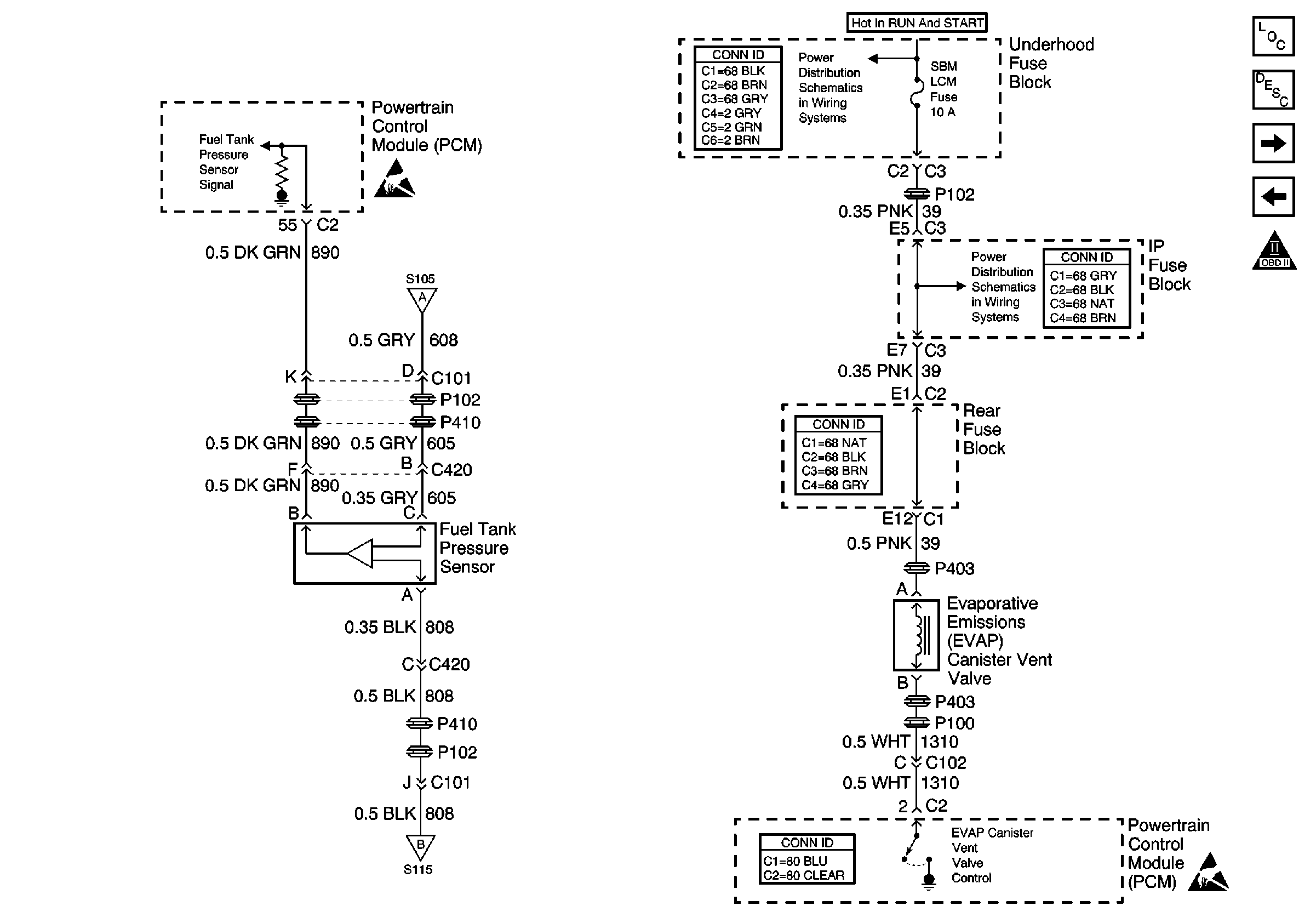Refer to
Sensors

and
Fuel Tank Pressure Sensor, EVAP Vent Valve

.
Circuit Description
The PCM uses the 5 volt reference B circuit as a sensor feed for the A/C refrigerant pressure sensor. The PCM monitors the voltage on the 5 volt Reference B circuit. If the voltage is out of tolerance, the PCM will set DTC P1639.
Conditions for Running the DTC
The ignition is ON.
Conditions for Setting the DTC
| • | The PCM detects a voltage out of tolerance condition on the 5 volt reference B circuit. |
| • | Above condition is present for longer than 10 seconds. |
Action Taken When the DTC Sets
| • | The PCM will illuminate the malfunction indicator lamp (MIL) during the second consecutive trip in which the diagnostic test has been run and failed. |
| • | The PCM will store conditions which were present when the DTC set as Freeze Frame/Failure Records data. |
Conditions for Clearing the MIL/DTC
| • | The PCM will turn OFF the malfunction indicator lamp (MIL) during the third consecutive trip in which the diagnostic has run and passed. |
| • | The history DTC will clear after 40 consecutive warm-up cycles have occurred without a malfunction. |
| • | The DTC can be cleared by using a scan tool. |
Diagnostic Aids
Important: Inspect the PCM and engine grounds for being secure and clean.
Check for the following conditions:
| • | Poor connection at the PCM. |
| Inspect harness connectors for backed out terminals, improper mating, broken locks, improperly formed or damaged terminals, and poor terminal to wire connection. |
| • | Damaged harness. |
| Inspect the wiring harness for damage. If the harness appears to be OK, observe the A/C pressure display on the scan tool while moving connectors and wiring harnesses related to the A/C refrigerant pressure sensor. A change in the A/C pressure display will indicate the location of the malfunction. |
Reviewing the Failure Records vehicle mileage since the diagnostic test last failed may help determine how often the condition that caused the DTC to be set occurs. This may assist in diagnosing the condition.
Test Description
The numbers below refer to the step numbers on the diagnostic table.
-
This vehicle is equipped with a PCM which utilizes an Electrically Erasable Programmable Read Only Memory (EEPROM). When the PCM is being replaced, the new PCM must be programmed. Refer to Powertrain Control Module Replacement/Programming
Step | Action | Values | Yes | No |
|---|---|---|---|---|
1 | Did you perform the Powertrain On-Board Diagnostic (OBD) System Check? | -- | ||
2 | Visually and physically check the PCM and engine grounds. Refer to Ground Distribution Schematics in Wiring Systems. Was a problem found? | -- | ||
3 |
Does the scan tool display voltage more than the first specified value or less than the second specified value? | 4.8 V 0.1 V | Go to DTC P0530 Air Conditioning (A/C) Refrigerant Pressure Sensor Circuit | |
4 |
Is voltage more than the specified value? | 5.5 V | ||
5 |
Is voltage more than the specified value indicated? | 0 V | ||
6 | Locate and repair short to voltage in the 5 volt reference B circuit. Is action complete? | -- | -- | |
7 | Is voltage less than the specified value indicated? | 4.5 V | ||
8 |
Was a problem found? | -- | ||
9 |
Was a problem found? | -- | ||
10 |
Is DTC P1639 set? | -- | ||
|
Important:: The replacement PCM must be programmed. Replace the PCM. Refer to Powertrain Control Module Replacement/Programming . Is action complete? | -- | -- | ||
12 | Replace the A/C refrigerant pressure sensor. Refer to Air Conditioning (A/C) Refrigerant Pressure Sensor Replacement in Heater, Ventilation, and Air Conditioning (HVAC). Is action complete? | -- | -- | |
13 |
Does the scan tool indicate DTC P1639 failed this ignition? | -- | System OK |
